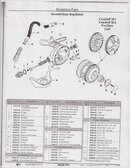Rich Keller
Contributor
This is a basic explanation of how to fix the most common cause of free flow in the field but this is not the only possible cause. The attached exploded view is for reference purposes, your reg will look different when you open it up but they all work on the same principal. When you inhale the diaphragm (part 17) is drawn in pushing on a lever (part 7) that opens the valve letting air into the second stage. All you need to do is adjust the lock nut (part 9) to adjust the the amount of pressure needed to open the valve, otherwise know as the cracking pressure, too lose and it will not open or breath hard, too tight and it will free flow. There is a way to determine the exact cracking pressure but if you are trying to fix this problem in the field we do not need to get into that as you can do this by trial and error based on how it feels when you inhale. Most free flow problems are due to the lock nut being too tight so all you need to do is back it off a little bit at a time, testing it after each adjustment, until it stops free flowing after you inhale. I usually just hold the cover and diaphragm in place when I am doing this rather then reattaching it with every adjustment attempt. Once you are at the point when you can inhale easily and remove the reg from your mouth without exhaling into it and then listen to make sure no air is escaping you are done. If it is adjusted perfectly the reg should free flow when you place it in the water with the mouth piece facing up and stop free flowing when you turn the reg over so the mouth piece is facing down. This is the most common cause of free flow problems and can be fixed in the field but it is not the only possible cause. If the intermediate pressure is set too high in your first stage or if the valve seat (part 3) is damaged this adjustment will likely not help much if at all. With a little more experience you could fix the valve seat problem by removing it and turning it over so the undamaged side is facing out. Adjusting the intermediate pressure is something you would need more experience and an IP gauge to fix but this is something that you would likely not be doing in the field. The only tools you need would be a wrench for the lock nut and whatever tool is required to remove the reg cover.





